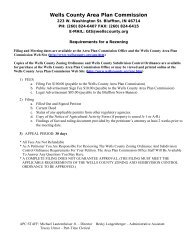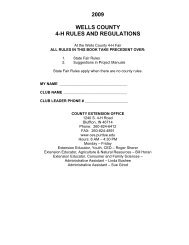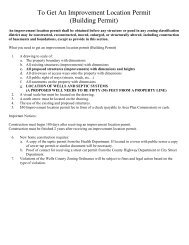Drug Test Comparisons Report - Wells County, Indiana
Drug Test Comparisons Report - Wells County, Indiana
Drug Test Comparisons Report - Wells County, Indiana
Create successful ePaper yourself
Turn your PDF publications into a flip-book with our unique Google optimized e-Paper software.
2006 Side-by-Side <strong>Drug</strong> <strong>Test</strong> Comparison Study Page 1 of 8<br />
(Urine <strong>Test</strong>s vs Saliva <strong>Test</strong>s)<br />
EXECUTIVE SUMMARY<br />
Beginning in 2006, the <strong>Wells</strong> <strong>County</strong> Probation Department began studying a<br />
different technology for drug testing involving persons on probation. Prompting<br />
the study was various challenges in the urine collection process for the Probation<br />
Department and any new test had to be proven against the trusted standard set by<br />
the existing urine sample tests. Several probation departments in <strong>Indiana</strong> had been<br />
using saliva tests due to their convenience and reliability. For these reasons, a<br />
study was initiated in August 2006 and completed in December 2006 to compare<br />
saliva tests with urine tests, and using a grant from the <strong>Wells</strong> <strong>County</strong> Citizens<br />
Against <strong>Drug</strong> Abuse (CADA) a side-by-side study of urine sample drug testing<br />
against saliva sample drug testing was completed. The results indicated that in<br />
most cases the tests matched each other in findings, but urine detected drugs,<br />
particularly marijuana, slightly more often than saliva. The difference between the<br />
two tests was not in accuracy or reliability, but different “windows” of detection.<br />
Marijuana in urine has a longer detection period than saliva; the detection periods<br />
in most other substances is similar.<br />
Despite the longer detection period of urine, the Court’s probation officers<br />
advocate continuing the use of saliva testing. A probation supervision strategy that<br />
includes in its arsenal both urine and saliva testing is an advantage when<br />
encountering individuals attempting to adulterate the testing process, and when<br />
certain conditions exist that prohibit urine sample testing (in homes or schools,<br />
probation officer of same sex of probationer is unavailable, time constraints exist).<br />
REPORT<br />
History: <strong>Wells</strong> <strong>County</strong> Probation has been submitting urine samples to Witham<br />
Memorial Hospital for drug testing since 1992. The testing procedure and reports<br />
have garnered a reliability that is nearly unquestioned in the <strong>Wells</strong> <strong>County</strong> Courts:<br />
a test finding, either positive or negative, is nearly always accepted as accurate. A<br />
toxicologist from Witham was always available for questions or testimony. The<br />
F:\SHARED\WP61\LETTERS\GREGS\Projects\<strong>Drug</strong> <strong>Test</strong> <strong>Comparisons</strong> <strong>Report</strong>.doc
2006 Side-by-Side <strong>Drug</strong> <strong>Test</strong> Comparison Study Page 2 of 8<br />
(Urine <strong>Test</strong>s vs Saliva <strong>Test</strong>s)<br />
costs were slightly higher than other urine testing, but the need for accuracy,<br />
reliability, and expert testimony outweighed arguments to go to less expensive<br />
tests. For these reasons, changing the probation department’s drug testing protocol<br />
was not considered for many years.<br />
Witham tested the urine samples probation submit for the following drugs:<br />
THC<br />
Amphetamines<br />
Cocaine metabolite<br />
Phencyclidine<br />
Barbiturates<br />
Opiates<br />
Benzodiazepines<br />
Alcohol<br />
The Probation Department received monthly invoices for tests submitted, and used<br />
the Probation Department’s “Urinalysis Fund” to satisfy debts. Probationers<br />
contribute to the fund as tests are administered them and must be paid in full prior<br />
to the completion of their probation supervision.<br />
Cumulative results of the past fourteen years of drug testing are listed in a table in<br />
the appendix of this report.<br />
Challenges: The Probation Department encounters several common challenges to<br />
the urine sample drug tests. The following represent the most common:<br />
1. A well-known challenge for the Probation Department is probationers<br />
“tampering” and “adulterating” their urine samples with tools and tactics available<br />
for interfering with a urine drug test. Devices and chemicals are available on-line<br />
to interfere with urine drug testing (see http://hightimes.com/ht/home/ for<br />
examples). This problem is minimized by observing the collection of urine<br />
samples. The <strong>Indiana</strong> General Assembly has also enacted law that sanctions<br />
individuals found tampering or adulterating their drug tests (IC 35-43-5-19).<br />
2. The probation population is about 80% male. However, for the nearly 410 male<br />
adult and juvenile active probationers there are only two male probation officers<br />
that can collect urine samples from offenders (compared to the 140 female<br />
offenders that the four female probation officers may collect sample from).<br />
Environmental constraints require “observed” collection therefore, only males can<br />
F:\SHARED\WP61\LETTERS\GREGS\Projects\<strong>Drug</strong> <strong>Test</strong> <strong>Comparisons</strong> <strong>Report</strong>.doc
2006 Side-by-Side <strong>Drug</strong> <strong>Test</strong> Comparison Study Page 3 of 8<br />
(Urine <strong>Test</strong>s vs Saliva <strong>Test</strong>s)<br />
collect urine samples from male offenders, and females from females. Caseloads<br />
and administrative duties often keep probation officers occupied and unable to take<br />
drug samples at any moment. Consideration was made for developing a urine<br />
collection area that negate the need for same sex drug testing, but costs and space<br />
in the Courthouse prohibit further consideration.<br />
3. Another challenge to probation resources is failure to provide valid urine<br />
samples by physiological, psychological, or intentional means. Generally viewed<br />
by probation officers as stalling tactics by the probationers in hopes of delaying<br />
their drug tests, considerable time is consumed by probation officers making<br />
multiple trips to the rest rooms in these cases of dry bladders, “stage fright”, or<br />
obviously over-hydrated samples. In some cases, multiple days are required to<br />
collect a single urine sample.<br />
4. In the past several years, there have been complaints from probationers (or their<br />
families) of violation of privacy due to being watched by a probation officer in a<br />
public restroom. These complaints were addressed with an investigation of more<br />
private testing procedures, the investigation concluded that the testing protocol was<br />
the best that could be provided in the provided environment and with limited<br />
resources. Considerations were given to space available in the Courthouse, costs<br />
to refurbish a “testing” room, and even out-sourcing the department’s drug testing.<br />
Considerations: Department drug testing procedures have been developed within<br />
the previously mentioned barriers. Additionally, procedures have considered<br />
factors of tests’ costs, windows of detection for drugs, and individual case plans.<br />
A final factor is the workload to the probation staff of conducting drug tests. When<br />
possible, drug tests administered by treatment programs and other corrections<br />
agencies substituted drug testing by the probation department when possible.<br />
Using drug tests of the other agencies saved time and money.<br />
The drug detection period of urine tests has also been a factor in drug testing<br />
procedures. Urine testing may test for some substances for up to two months. As<br />
a practical matter, drug testing in the first two months of probation would be useful<br />
only for the purpose of initial assessments, and could not be used to determine<br />
compliance of probation rules, therefore, probation officers could not determine if<br />
drug use was before or after the defendant’s sentencing hearing. Once the first two<br />
months of probation had lapsed urine tests permitted probation officers to<br />
determine drug use for this community’s second most popular drug of choice<br />
(marijuana) between most risk level contacts.<br />
F:\SHARED\WP61\LETTERS\GREGS\Projects\<strong>Drug</strong> <strong>Test</strong> <strong>Comparisons</strong> <strong>Report</strong>.doc
2006 Side-by-Side <strong>Drug</strong> <strong>Test</strong> Comparison Study Page 4 of 8<br />
(Urine <strong>Test</strong>s vs Saliva <strong>Test</strong>s)<br />
Recognizing the challenges and benefits of urine tests, consideration of alternative<br />
testing tools was considered. Saliva tests had appeal several years ago due to their<br />
reliability. However, salvia testing has a much shorter window of detection for this<br />
marijuana: a drug this department must watch for. Saliva tests are recognized by<br />
the <strong>Indiana</strong> Code as a chemical test for determining the presence of a controlled<br />
substance under IC 12-7-2-26.5.<br />
Since first learning about saliva testing, strides have been made to lengthen the<br />
detection period of marijuana. Many studies were reviewed and several vendors<br />
were considered. One vendor was finally selected that offered solid credentials of<br />
service to probation departments.<br />
The Side-by-Side <strong>Test</strong>: Beginning in August 2006, a simple side-by-side study<br />
was performed to determine the results of each testing tool, and the side-by-side<br />
test was concluded in December 2006. It was expected beforehand that the tests<br />
results would not mirror each other perfectly, and the purpose of the side-by-side<br />
comparison was to determine under what circumstances each test might best be<br />
used. We were especially interested to determine if, as in other jurisdictions, many<br />
other substances would be found (such as cocaine). Probation officers were also<br />
going to attempt to determine when a person used the substances found in the drug<br />
tests for learning detection periods.<br />
Using grant money from CADA, 80 salvia tests were purchased to run at the same<br />
time as the urine sample for each probationer: thus, each person tested in the trial<br />
period provided a urine sample and a saliva sample. The probationer was not<br />
charged for a saliva test, but they were charged the standard fee for a urine test.<br />
The results of each test were recorded in the probation department’s caseload<br />
management system. The following results were obtained from the tests.<br />
Results: Matched and Unmateched <strong>Test</strong>s<br />
Total Non-<br />
Matches<br />
28%<br />
Total<br />
Matches<br />
72%<br />
Results: In the Results: Matched<br />
and Unmatched <strong>Test</strong>s graph, we<br />
learn that over seventy-two percent<br />
of the time a urine sample and the<br />
corresponding saliva sample<br />
indicated the same results. We<br />
found this encouraging because we<br />
anticipated differences, but did not<br />
know whether the differing<br />
windows of detection would cause<br />
us to find less use of drugs. Our<br />
F:\SHARED\WP61\LETTERS\GREGS\Projects\<strong>Drug</strong> <strong>Test</strong> <strong>Comparisons</strong> <strong>Report</strong>.doc
2006 Side-by-Side <strong>Drug</strong> <strong>Test</strong> Comparison Study Page 5 of 8<br />
(Urine <strong>Test</strong>s vs Saliva <strong>Test</strong>s)<br />
supervision practices often require up to sixty days between appointments and<br />
determining drug use between appointments is a significant part of our<br />
enforcement of probation conditions. We did not include in the study the<br />
frequency of probationer appointments with the results of the tests.<br />
Results: Of Those That Matched<br />
Number of<br />
Negatives<br />
69%<br />
PAST URINALYSIS REPORTS: Positive Findings<br />
2004<br />
36.31%<br />
2005<br />
32.43%<br />
2003<br />
26.85%<br />
Number of<br />
Positives<br />
31%<br />
2000<br />
28.05%<br />
2002<br />
23.89%<br />
2001<br />
32.62%<br />
The chart to the side entitled<br />
Results: Of Those That Matched,<br />
summarizes the results of those<br />
tests where both urine and saliva<br />
tests matched. These results<br />
indicated 69% of the matched tests<br />
both detected no illicit substances.<br />
Conversely, both drug testing tools<br />
confirmed illegal drug use 31% of<br />
the time. These results are<br />
encouraging because the positive<br />
findings fall into the historical<br />
range of positive drug tests findings. A separate chart, Past Urinalysis <strong>Report</strong>s:<br />
Positive Findings, has been provided to indicate the positive drug test findings<br />
since the year 2000.<br />
probation popuations.<br />
Historically, positive<br />
drug tests are found in<br />
probationers about 30%<br />
of the time. Since we<br />
altered our drug testing<br />
practices very little<br />
during this time period,<br />
this finding suggests<br />
that saliva testing may<br />
be an acceptable<br />
alternative to urine<br />
testings in the<br />
Addressing the test results where the tests differed in their findings (in 26% of the<br />
tests): we expected differences and the side-by-side comparison did not surprise us<br />
much. We anticipated that urine would pick up some substances more often than<br />
F:\SHARED\WP61\LETTERS\GREGS\Projects\<strong>Drug</strong> <strong>Test</strong> <strong>Comparisons</strong> <strong>Report</strong>.doc
2006 Side-by-Side <strong>Drug</strong> <strong>Test</strong> Comparison Study Page 6 of 8<br />
(Urine <strong>Test</strong>s vs Saliva <strong>Test</strong>s)<br />
Results: Of Those Not Matched<br />
Number of Urine<br />
Number of Diluted Refused, 1<br />
Urine, 2<br />
Number of Urine<br />
Positives, 14<br />
Number of Oral<br />
Positives, 6<br />
saliva. National studies<br />
indicated that that the<br />
difference in windows of<br />
detection between saliva and<br />
urine would find fewer<br />
marijuana users from saliva<br />
testing. We had also hear that<br />
cocaine findings from saliva<br />
testing showed up more often<br />
than urine testing. The chart<br />
entitled Results: Of Those Not<br />
Matched, shows a summary of<br />
these findings.<br />
Essentially, we learned that urine had an advantage to salvia in finding drugs in<br />
probationers approximately 84% of the time, to saliva’s 63% of the time. There<br />
were four occasions where urine was either diluted or refused: saliva found drug<br />
use in only one of these situations.<br />
In the final chart, Results: <strong>Drug</strong>s Found, we confirmed what we anticipated:<br />
Results: <strong>Drug</strong>s Found<br />
marijuana remains <strong>Wells</strong><br />
<strong>County</strong>’s drug of choice<br />
100%<br />
after alcohol (and tobacco<br />
80%<br />
if we are counting this<br />
substance). We also<br />
60%<br />
learned that marijuana is<br />
40%<br />
most detected by urine<br />
20%<br />
testing in the side-by-side<br />
0%<br />
tests. The “Both<br />
Benzodiazapi<br />
Marijuana Cocaine<br />
Alcohol Opiates<br />
nes<br />
Positive” category<br />
Saliva Positive/Urine 3 2 0 0<br />
indicates that in about half<br />
Negative<br />
the cases both tests<br />
Urine Positive/Saliva 12 0 2 0<br />
Negative<br />
revealed marijuana use. In<br />
Both Positive 15 4 1 0 1<br />
cases where only one drug<br />
test revealed marijuana,<br />
most were detected by urine alone. So of 28 findings of marijuana, 13 were found<br />
by both tests, 12 by only urine, and 3 by only saliva.<br />
Cocaine was found in six tests: four were found in both tests; saliva located<br />
cocaine in the other tests alone. Based upon other jurisdiction’s findings, we<br />
F:\SHARED\WP61\LETTERS\GREGS\Projects\<strong>Drug</strong> <strong>Test</strong> <strong>Comparisons</strong> <strong>Report</strong>.doc
2006 Side-by-Side <strong>Drug</strong> <strong>Test</strong> Comparison Study Page 7 of 8<br />
(Urine <strong>Test</strong>s vs Saliva <strong>Test</strong>s)<br />
expected this result, but remain surprised by the findings of cocaine in the<br />
community. The other substances fit the previous year’s findings, and remain low<br />
in total findings.<br />
Implications to Probation Supervision: Supervision strategies are being<br />
adopted that account for greater use of risk and needs assessments. <strong>Drug</strong> testing is<br />
a fundamental part of supervision, and a part of each individual’s case plans.<br />
Longer windows of detection work well for probationers checking in once a<br />
month, but for individuals who are suspected of having used drugs within a few<br />
hours, many drugs have not had time to be processed by the body to be manifested<br />
in urine. This is especially a problem when schools call juveniles’ probation<br />
officers about suspected use on the way to school, or any probationer that exhibits<br />
intoxicated behavior during a probation contact. Probation officers have<br />
intoximeters to determine the immediate use of alcohol, but other ingested drugs<br />
cannot always be detected.<br />
Due to these reasons in aggregate, probation officers consider the use of both urine<br />
and saliva drug testing for in their supervision plans. Both tests have advantages<br />
and disadvantages: the following outlines advantages for each drug test method.<br />
Saliva -<br />
Cross-gender testing is not an issue.<br />
Issues of modesty (environmental privacy) are minimized.<br />
Saliva’s shorter window of detection is advantage in situations where suspected<br />
use was very recent: i.e. just placed on probation; suspicion of being under the<br />
influence.<br />
Greater sensitivity to some drugs of abuse (e.g., cocaine).<br />
Fewer (if any) ability to adulterate tests.<br />
Fewer problems with failure to generate sufficient testing sample.<br />
Saliva is not a bio-hazard.<br />
Urine -<br />
<strong>Test</strong>ing for marijuana over a longer course of time.<br />
Urine tests are already trusted as reliable in <strong>Wells</strong> <strong>County</strong>.<br />
<strong>Wells</strong> <strong>County</strong> Probation will benefit to utilizing both tests in its strategic plans for<br />
probation supervision. An arsenal that includes both tests permits the probation<br />
department to choose the best test in the immediate circumstances. Furthermore,<br />
probationers will find that they will not know which test will be administered and<br />
be frustrated plans to tamper or adulterate tests.<br />
F:\SHARED\WP61\LETTERS\GREGS\Projects\<strong>Drug</strong> <strong>Test</strong> <strong>Comparisons</strong> <strong>Report</strong>.doc
2006 Side-by-Side <strong>Drug</strong> <strong>Test</strong> Comparison Study Page 8 of 8<br />
(Urine <strong>Test</strong>s vs Saliva <strong>Test</strong>s)<br />
Appendix<br />
URINALYSIS REPORTS<br />
Year No. <strong>Test</strong>s<br />
No.<br />
Positive %Positive<br />
1992 73 15 20.55%<br />
1993 76 17 22.37%<br />
1994 180 38 21.11%<br />
1995 141 36 25.53%<br />
1996 217 33 15.21%<br />
1997 329 72 21.88%<br />
1998 218 58 26.61%<br />
1999 179 39 21.79%<br />
2000 246 69 28.05%<br />
2001 187 61 32.62%<br />
2002 180 43 23.89%<br />
2003 149 40 26.85%<br />
2004 179 65 36.31%<br />
2005 148 48 32.43%<br />
2006 180 82 45.56%<br />
F:\SHARED\WP61\LETTERS\GREGS\Projects\<strong>Drug</strong> <strong>Test</strong> <strong>Comparisons</strong> <strong>Report</strong>.doc
















